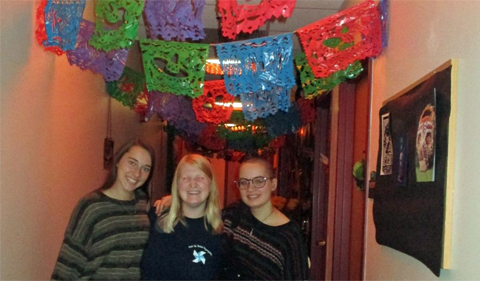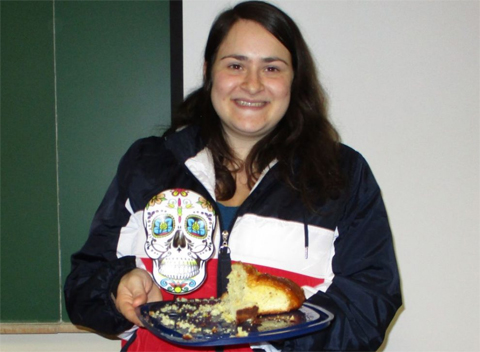
Three of Sigma Delta Pi’s members pose under papel picado while decorating Gordy Hall for Día de los Muertos.
In order to celebrate Día de los Muertos properly, members of Sigma Delta Pi decked out the Modern Languages Department in traditional decorations on Oct. 28, alongside setting up an altar with personal, regional and informational artifacts.
Using papel picado (Mexican perforated paper), calaveras (skulls), cempasuchiles (tissue paper flowers), and many other holiday adornments, the offices of Gordy Hall looked festive and provided context for those not familiar with the celebration.
At and around the altar, the centerpiece of the event, Sigma Delta Pi members hung posters showcasing historical and religious explanations of Día de los Muertos. The organization’s altar also served as a proper altar for Modern Languages faculty members who participate in the holiday, who used it to pay homage to their loved ones.
During the altar’s set up, many Sigma Delta Pi members lent a hand wherever it was needed, whether taping flowers to office doors, pinning fabric to ceiling lights, or arranging miniature statues on the altar. All of the decorating was overseen by adviser Dr. Betsy Partyka, so that the building would be ready before the actual Día de los Muertos celebration three days later.

Members of Sigma Delta Pi and the Spanish Club pose with their altar after decorating Gordy Hall for Día de los Muertos.
On Oct. 31, Sigma Delta Pi threw a party to celebrate Día de los Muertos, completed with its annual “Pan de Muertos” (bread of the dead) competition. Partyka, Dr. David Burton (Emeritus), Suzy Aftabizadeh (president of Sigma Delta Pi) and Zoe Kiourtsis (recently inducted member) all baked loaves for the competition.
All of the bread was delicious, and after a few moments of letting the bread settle in attendees’ taste buds, it was time to vote on a winner. Graduate and undergraduate students gathered around the bread to get one final taste before casting their vote. After all the votes were in, the results yielded that “pan (bread) number 1,” made by Kiourtsis, was the winner. It had an exceptional simple syrup, a great crust and shape, as well as the right amount of orange zest inside. Kiourtsis won a stylish Día de Los Muertos hoodie, which is perfect for the upcoming Athens winter.
After attendees went into a carb coma, they relaxed and chatted in Spanish and learned about the culture of pan de muertos. According to an article by Dania Vargas Austryjak highlighting the history of pan de muertos, some legends of pan de muertos’ history dates back to pre-Hispanic times. One legend recalls that when ancient civilizations performed sacrifices to the gods, the heart of a princess would be mixed in a pot with amaranth, and the leader would bite into it. However, when the Spaniards came to complete this, the indigenous people made bread into the shape of hearts and used red sugar to represent the blood.
Regardless of the origin of pan de muertos, the bread relates back to death. Its round shape serves as a body; the long extremities atop represent bones; and, the round piece on top represents the skull. Recipes vary from region to region in Mexico, but they are sure to be delicious.
If you’re hungry after reading this, below is a recipe from All Recipes for a delicious pan de muertos. If you make this recipe, feel free to share your final pictures with Sigma Delta Pi on Instagram (@ousdp) or through email.
Pan de Muertos
Ingredients:
For the bread: ¼ cup butter, ¼ cup of milk, ¼ cup of warm water 3 cups of all-purpose flour, 1 ¼ teaspoons of active dry yeast, ½ teaspoon of salt, 2 teaspoons anise seed, ¼ cup of white sugar, 2 eggs beaten, 2 teaspoons of orange zest.
For the glaze: ¼ cup of sugar, ¼ cup of orange juice, 1 tablespoon of orange zest, and 2 tablespoons of white sugar for sprinkling.
Instructions:
- Heat the milk and the butter together in a medium saucepan, until the butter melts. Remove from the heat and add the warm water. The mixture should be around 110 degrees F (43 degrees C).
- In a large bowl combine 1 cup of the flour, yeast, salt, anise seed and 1/4 cup of the sugar. Beat in the warm milk mixture then add the eggs and orange zest and beat until well combined. Stir in 1/2 cup of flour and continue adding more flour until the dough is soft.
- Turn the dough out onto a lightly floured surface and knead until smooth and elastic.
- Place the dough into a lightly greased bowl cover with plastic wrap and let rise in a warm place until doubled in size. This will take about 1 to 2 hours. Punch the dough down and shape it into a large round loaf with a round knob on top. Place dough onto a baking sheet, loosely cover with plastic wrap and let rise in a warm place for about 1 hour or until just about doubled in size.
- Bake in a preheated 350 degrees F (175 degrees C) oven for about 35 to 45 minutes. Remove from oven let cool slightly then brush with glaze.
To make the glaze:
In a small saucepan combine the 1/4 cup sugar, orange juice and orange zest. Bring to a boil over medium heat and boil for 2 minutes. Brush over top of bread while still warm. Sprinkle glazed bread with white sugar.




















Comments